Pre-Sunrise Scattered Sunlight, Best Neptune, Young Moon Meets Inner Planets and the Scorpion’s Snippers, and Soaring with Cygnus!
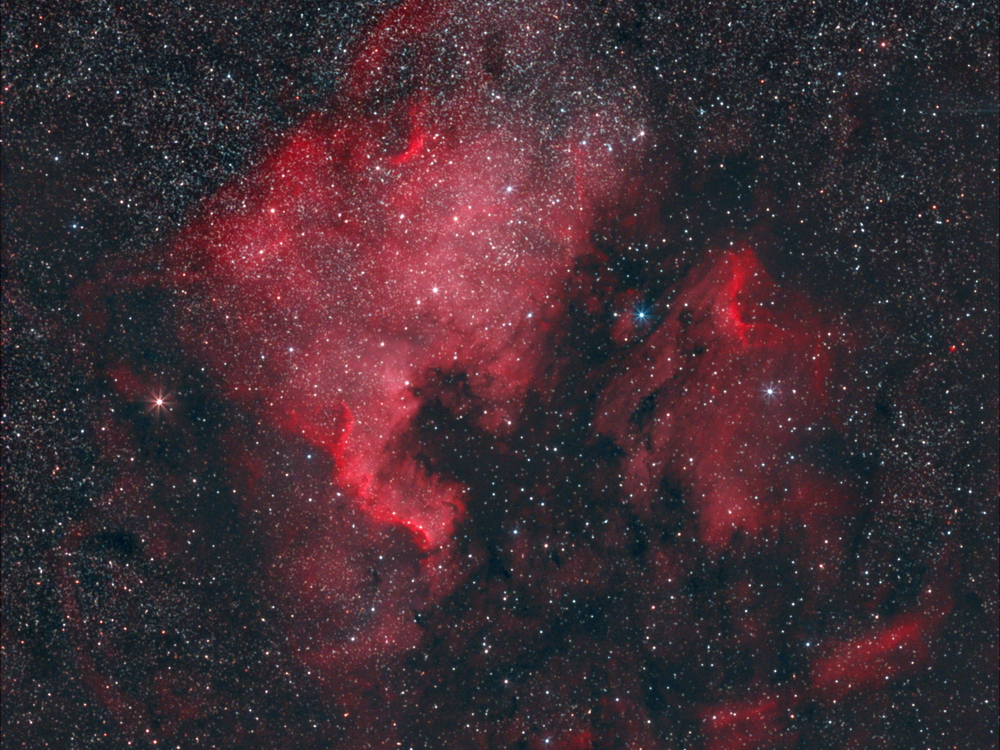
This gorgeous image of the North America Nebula, and the Pelican Nebula to its right, was captured by Roman Kulesza. The pink colour arises from glowing hydrogen gas. Opaque dust in the foreground is separating the single large gas cloud into two nebulas, and producing the unique shapes. It was the SkyNews Photo of the Week for September 16, 2016. The image spans several finger widths left-to-right (or 4 degrees east-west).
Hello, September Sky-watchers!
Here are your Astronomy Skylights for the week of September 5th, 2021 by Chris Vaughan. Feel free to pass this along to your friends and send me your comments, questions, and suggested topics. You can also follow me on Twitter as @astrogeoguy! Unless otherwise noted, all times are expressed in Eastern Time. To subscribe to these emails please click this MailChimp link.
I can bring my Digital Starlab portable inflatable planetarium to your school or other daytime or evening event, or teach a session online. Contact me through AstroGeo.ca, and we’ll tour the Universe, or the Earth’s interior, together! My terrific new book with John A. Read titled 110 Things to See With a Telescope (in paperback and hardcover) is a guide to viewing the deep sky objects in the Messier List – for both beginners and seasoned astronomers.
The moon will pass its new phase on Monday evening, and then gradually return to shine in the western post-sunset sky at midweek. In the meantime, the young moon will pass close to both Mercury and Venus. The dark night-time skies this week will be ideal for viewing asteroid Pallas and Neptune near opposition, and the best sights in Cygnus the Swan. Finally, mighty Jupiter will host many moon shadow transits this week, including a pair on Sunday night! Read on for your Skylights!
Rosh Hashanah
“Shanah Tovah!” to my Jewish friends. In the Jewish lunisolar calendar, months begin at sunset on new moon, or with the first glimpse of the young crescent moon after new. Nissan is the first month in the Jewish calendar. Nissan 1, the ecclesiastical, or secular, new year begins at the new moon closest to the March Equinox. The Jewish calendar’s seventh month, which is named Tishrei – always falls into September or October on the Gregorian calendar. Tishrei hosts the Jewish High Holidays – Rosh Hashanah, Yom Kippur, Sukkot, Shmini Atzeret, and Sinchat Torah.
Rosh Hashanah, or the religious Jewish New Year, falls on Tishrei 1. It celebrates the creation of the world and marks the beginning of the Days of Awe, a 10-day period of introspection and repentance that culminates with the Day of Atonement, Yom Kippur. The traditional greeting during Rosh Hashanah is the phrase “Shanah tovah”. This year Rosh Hashanah will commence at sunset on Monday, September 6.
The Sun and the Moon
This weekend the sun is sporting two groups of sunspots that will be visible in safely filtered binoculars and telescopes. Those should remain observable for most of this week as they are carried across the rotating sun. I wrote about sunspots and other solar features last week here.
The moon will make its monthly trip past the sun on Monday evening at 8:51 pm EDT. During every new moon phase, sunlight can only touch the hidden, far side of the moon. Since the moon is positioned less than a palm’s width of the sun, the moon is unobservable from anywhere on Earth – unless there’s a solar eclipse. Lunar phases occur at the same instant for everyone on Earth – but not at the same local time. This new moon happens at 0:51 Greenwich Mean Time on Tuesday. To find out when any celestial event will happen where you live, add or subtract the number of hours of difference from GMT in your time zone.
On Monday morning, just hours before it reaches its new phase, you might spot the extremely slim sliver of the old moon shining just above the eastern horizon before sunrise. On Tuesday after sunset, sharp eyes and a cloudless western horizon might allow you spot the young, 1%-illuminated crescent moon sitting 1.4 fist diameters to the right (or 14° to the celestial northwest) of Mercury. The following evening, the now more substantial crescent moon (4.8%-illuminated) will climb to shine a slim palm’s width to the upper right (or 5 degrees to the celestial north) of Mercury. The planet will become apparent as the sky darkens beyond 7:30 pm local time and will set 30 minutes later. The moon will follow it down half an hour later. These three scenarios will be a challenge to see from mid-northern latitudes, but should be quite easy from low-latitude locations. Use binoculars only after the sun has completely set.

In the west-southwestern sky after sunset on Thursday, look for the crescent moon shining several finger widths to the upper right (or 4° to the celestial northwest) of the very bright planet Venus. The main belt asteroid designated (4) Vesta will be there, too – positioned about double the moon’s distance from Venus. The magnitude 7.7 asteroid will be somewhat difficult to see unless you are viewing it from a southerly latitude, where skies darken quickly after sunset. All three solar system bodies will be travelling eastward through Virgo (the Maiden), parallel to the ecliptic. On Thursday, you can use binoculars to hunt for Vesta only a moon’s diameter above the medium-bright star named 80 Virginis. The moon will dance away from them after Thursday, but Venus and Vesta will continue to travel together. Compare their nightly positions with Virgo’s brightest star, Spica.
On Friday and Saturday, the waxing crescent moon will traverse Libra (the Scales). By then our planet’s partner will be high enough for clearer viewing through binoculars and telescopes. Start looking at dusk because the moon will set by about 10 pm local time. The zone to the right (lunar east) of the curved lunar terminator will look spectacular because sunlight arriving there will be near horizontal, casting long and deep black shadows beside every bump, hill, mountain, and crater rim. You can also watch for subtle Earthshine, sunlight reflected from Earth that slightly brightens the moon’s dark hemisphere. My mother used to call it “the old moon in the new moon’s arms”.

Friday evening’s moon will be positioned just to the right (celestial west) of the three up-down stars that form Scorpius’ claws. Actually, his limbs used to extend three times farther, measuring from the very bright, reddish star Antares at the head of the creature. The claw tips were once Libra’s stars Zubeneschamali, Zubenelhakrabi, and Zubenelgenubi (or Beta, Gamma, and Alpha Librae, respectively). The Arabic root word “zuben” denotes “claw”. Now the claws terminate at the “knuckle” stars Acrab, Dscubba, and Fang (or Beta, Delta, and Pi Scorpii, respectively), which are only a palm’s width to the right (west) of Antares. The moon will end this week shining a few degrees above Antares next Sunday night.
Morning Zodiacal Light for Mid-Northern Observers
During autumn at mid-northern latitudes every year, the ecliptic extends nearly vertically upward from the eastern horizon before dawn. That geometry favors the appearance of the faint zodiacal light in the eastern sky for about half an hour before dawn on moonless mornings. Zodiacal light is sunlight scattered by interplanetary particles that are concentrated in the plane of the solar system – the same type of material that produces meteor showers. It is more readily seen in areas free of urban light pollution. For observers at low latitudes, the ecliptic is nearly vertical all year round, making the light a frequent phenomenon. Sadly, observers north of 60° latitude miss out.
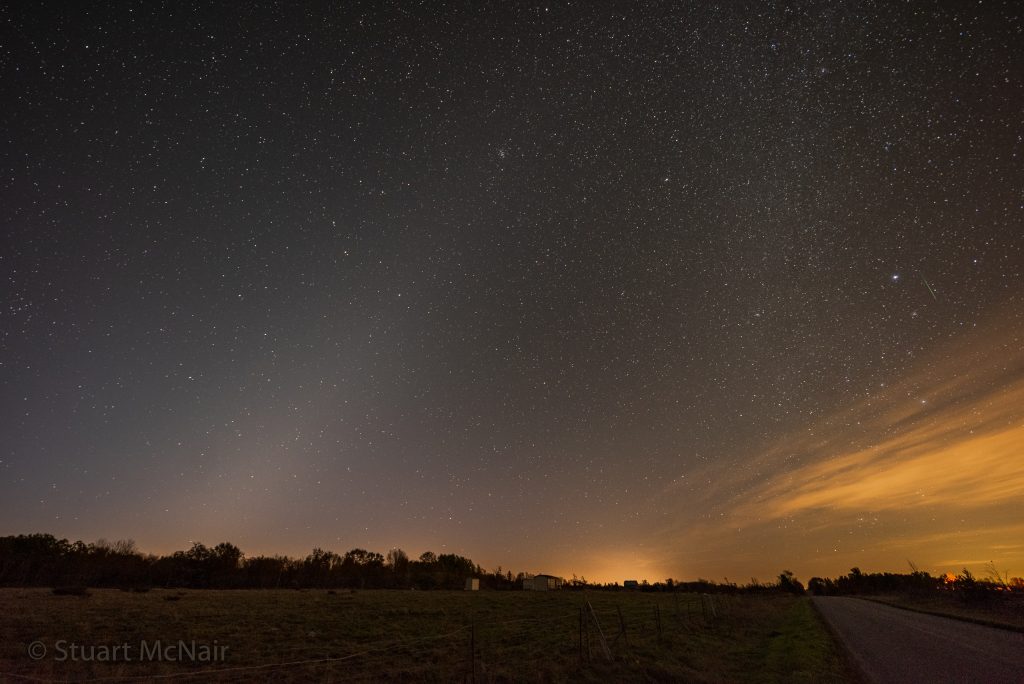
If your location favors it, between now until the full moon on September 20, look for a broad wedge of faint light extending upwards from the eastern horizon and centered on the ecliptic. It will be strongest in the lower third of the sky, below the twin stars Castor and Pollux. Try taking a long exposure photograph to capture it. Don’t confuse the zodiacal light with the Milky Way, which is positioned nearby in the southeastern sky.
The Planets
I already mentioned above that magnitude 0.0 Mercury and forty times brighter Venus will share the western post-sunset sky this week. Mercury can be seen with difficulty, sitting very low in the sky, starting at about 8 pm local time – but it sets about 20 minutes later. Observers who live in the tropics or the Southern Hemisphere will see Mercury (and Venus) easily – higher, and in a dark sky.
This week, extremely bright Venus will emerge from the post-sunset twilight by 8 pm local time then set at about 9 pm. Venus will not be positioned much higher than the trees and rooftops, so you might need to walk around until you find an open view to the west-southwest. When viewed in a backyard telescope Venus will exhibit a small, featureless, football-shaped disk, because it’s only 70%-illuminated right now. It will grow in size and wane in phase every week. Aim your telescope at Venus as soon as you can spot the planet in the sky (but ensure that the sun has completely disappeared first). That way, Venus will be higher and shining through less distorting atmosphere – giving you a clearer view.
Tonight (Sunday evening) Venus will shine only a thumb’s width above (or 1.5 degrees to the celestial north of) the star Spica, allowing them to appear together in binoculars and low power telescopes. (Venus is far brighter.) The pair will be binoculars-close until Wednesday, but ensure that the sun has fully set before using optical aids to view them. And don’t forget to catch the crescent moon near Venus on Thursday.
As Venus descends in the west-southwest at 8 pm local time, one-third as bright Jupiter will come into view sitting about as high up in the darkening southeastern sky. Half an hour later, the yellowish dot of Saturn will appear less than two fist diameters to Jupiter’s upper right (or 17° to the celestial west). The two gas giants will cross the night sky together amidst the faint stars of Capricornus (the Sea-Goat) and then set in the southwest during the wee hours. Sadly, for telescope owners, the low position of the ecliptic on September evenings is keeping those planets in the lower third of the sky, where their light must punch through two to three times as much of Earth’s distorting atmosphere. (In a few years, they’ll arrive at a position on the ecliptic that reaches much higher at night – but we’ll need warm sweaters and jackets to view them!)
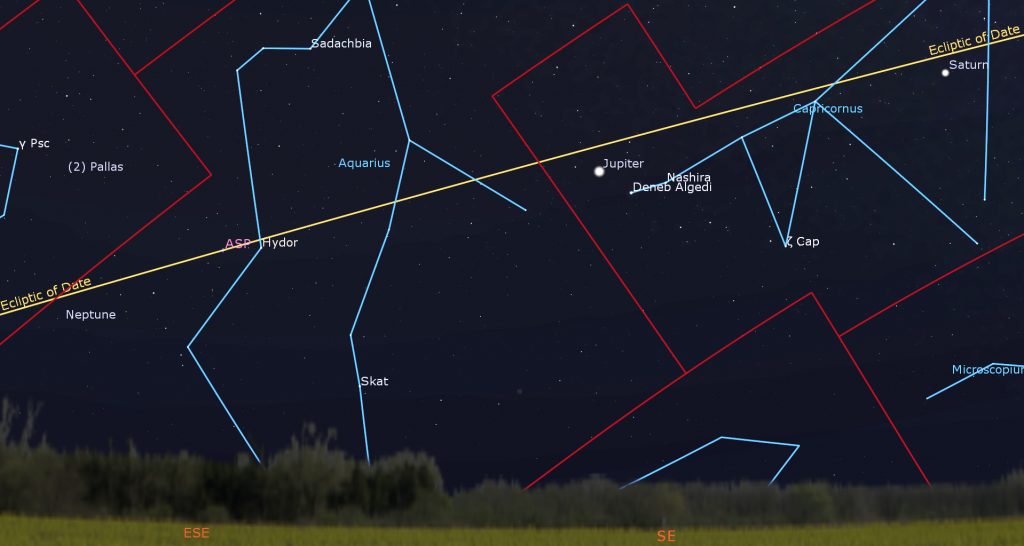
Saturn, adorned with its large and bright rings, is spectacular and thrilling when seen in almost any telescope! The rings are about 2.4 times the diameter of Saturn’s globe. If your optics and the seeing conditions are good, try to see the Cassini Division, a narrow gap that separates the outer and inner rings. Look for a faint dark belt encircling the planet, too.
From here on Earth, Saturn’s axial tilt of 26.7° lets us see the top of its ring plane, and allows its brighter moons to array themselves all around the planet. Saturn’s largest and brightest moon Titan never wanders more than five times the width of Saturn’s rings from the planet. Much fainter Iapetus can stray up to twelve times the ring width. Iapetus is dark on one hemisphere and bright on the other, so it looks dimmer when it is east of Saturn, and it looks brighter when it is west of Saturn (as it is this week). The next brightest moons Rhea, Dione, Tethys, Enceladus, and Mimas all stay within one ring width of Saturn.
During this week, Titan will migrate counter-clockwise around Saturn, moving from the left (celestial east) of the planet tonight to the lower right (celestial southwest) of Saturn next Sunday. (Remember that your telescope will probably flip the view around.) How many of the moons can you see in your telescope?
Turning now to Jupiter, binoculars and small telescopes will show you the planet’s four large Galilean moons named Io, Europa, Callisto, and Ganymede. Since Jupiter’s axial tilt is a miniscule 3°, those moons always appear to be strung like beads along a straight line that passes through the planet, and parallel to Jupiter’s dark equatorial belts. The moons’ arrangement varies from night to night.
For observers in the Eastern Time Zone with good telescopes, the Great Red Spot (or GRS) will be visible while it crosses Jupiter this evening (Sunday), Tuesday evening, Thursday night, after dusk on Friday, and next Sunday evening. It can also be observed during the wee hours on Tuesday and Thursday morning.
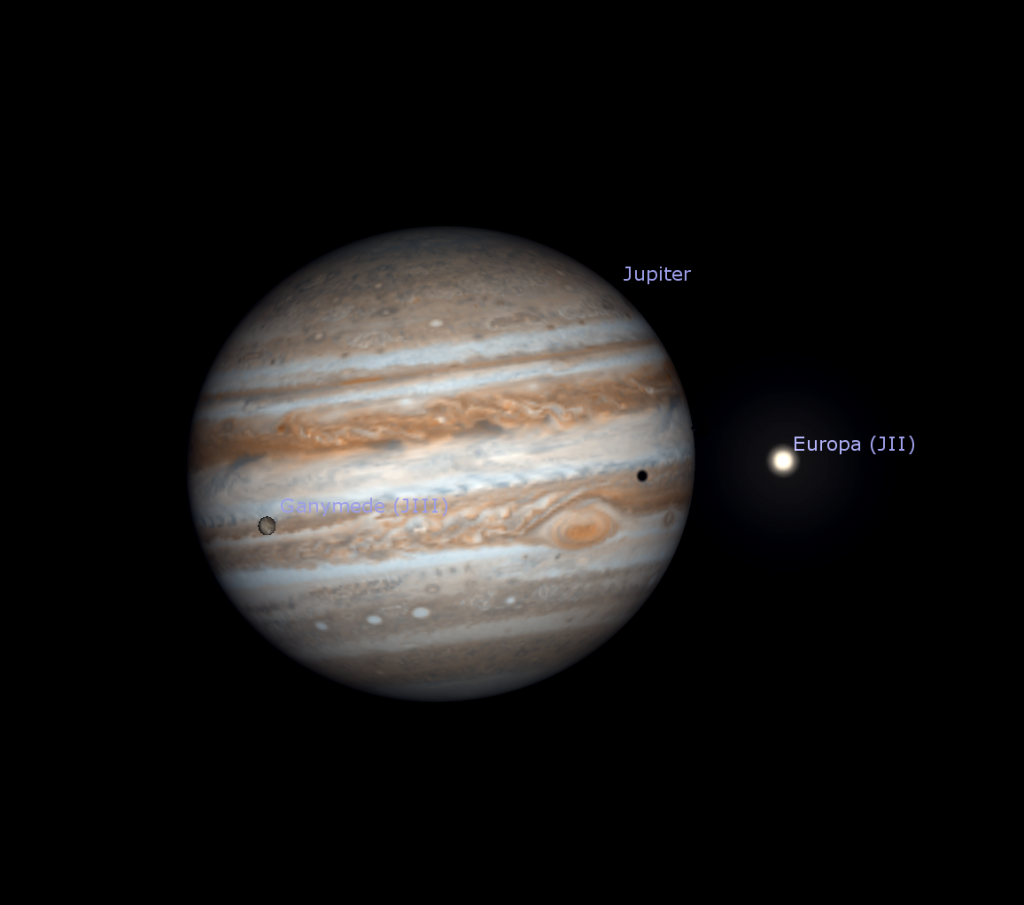
From time to time, the small round black shadows cast by Jupiter’s Galilean moons become visible in amateur telescopes when they cross (or transit) the planet’s disk. Europa’s shadow will cross tonight (Sunday evening), with the Great Red Spot, from dusk until 9:50 pm EDT. Ganymede’s big shadow will also transit on Sunday night from 10:45 pm to 2:15 am EDT, Io’s little shadow will be visible on Saturday night between 10:05 pm and 12:20 am EDT, and Europa’s shadow crosses next Sunday night from 9:40 pm to 12:20 am EDT.
This week Magnitude 5.7 Uranus will be observable nearly all night after it rises just before 10 pm local time. But wait until it has climbed higher in late evening to view it. Uranus is spending all of this year parked below Hamal and Sheratan, the two brightest stars in Aries (the Ram). The blue-green planet is currently surrounded by the moderately bright (5th magnitude) stars Sigma, Omicron, Rho, and Pi Arietis – creating a distinctive asterism for anyone viewing Uranus in binoculars.
Neptune will reach peak visibility for the year at opposition next week – but the moonless evenings this weekend are perfect times to view it. The distant, blue planet is located near the border between Aquarius (the Water-Bearer) and Pisces (the Fishes) – almost three fist diameters to the left (or 27° to the celestial east) of Jupiter. Neptune will rise just before 8 pm local time and reach peak visibility, halfway up the southern sky, around 1:30 am local time.
On Saturday, September 11, the main belt asteroid designated (2) Pallas will reach opposition and its minimum distance from Earth for this year. On the nights near opposition, Pallas will rise at sunset and set at sunrise, and shine with a peak visual magnitude of 8.55. That’s within reach of backyard telescopes, but wait until the asteroid has risen higher for the best view of it – at 9 pm local time or later. Pallas will be situated in western Pisces (the Fishes), several finger widths to the right (or 4 degrees to the celestial southwest) of the medium-bright star Gamma Piscium.
Soaring with Cygnus
With no moon in the sky after early evening, darkness falling earlier, and evening temperatures mild and bug-free, this will be an ideal week to get out under the stars. Objects in the sky directly overhead will always appear at their best because you are seeing them through the least amount of intervening air. In early evening during mid-September every year, the constellations of Lyra (the Harp), Cygnus (the Swan), and Draco (the Dragon) surround the zenith. Last week’s tour of Lyra highlighted some of the objects you can look at with binoculars and small telescopes. This time we’ll soar into Cygnus!
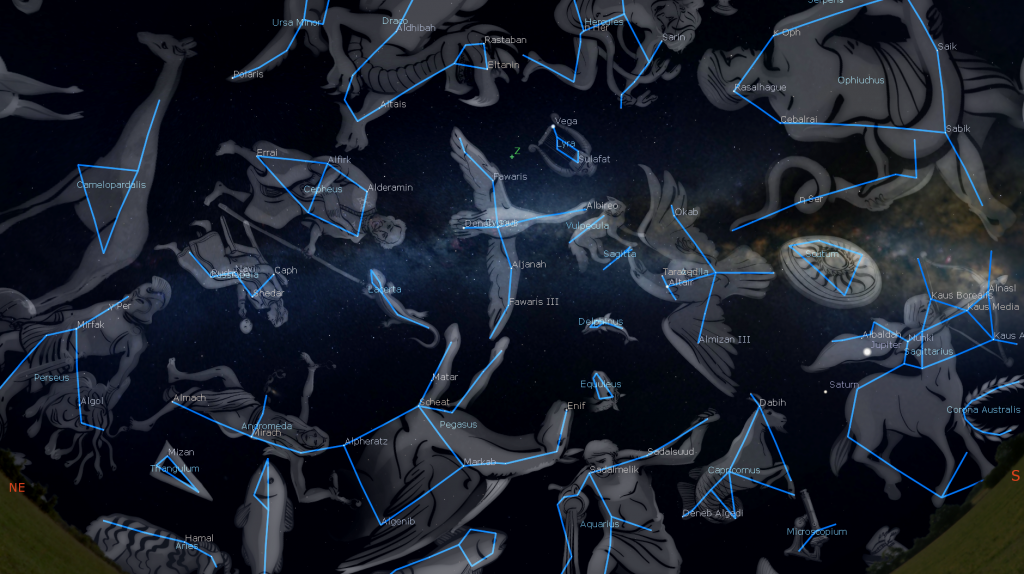
Head outside on the next clear evening, face east, and look nearly overhead for the very bright star Vega. Below it is the realm of the great constellation Cygnus (the Swan). Its brightest stars also form the asterism called the Northern Cross. In size, Cygnus is the 16th largest of the 88 official constellations. By using your closed fist held at arm’s length, you can see that the bright stars of the swan span more than two fists (or 22°) head to tail, and nearly four fists (or 36°) across the wingspan. Its official boundary includes a large northeastern section that is devoid of bright stars, but is loaded with rich nebulas and star fields.
Cygnus position 40° north of the celestial equator allows the constellation to be visible from every city on Earth. Antarctica sees no portion of it, observers at the southern tip of South America only ever glimpse its southernmost stars, and the rest of the Southern Hemisphere sees it only at this time of year – on (their) spring evenings. For observers in mid-northern latitudes around the world, some of Cygnus’ more northerly stars are circumpolar – that is, they never drop below the horizon.
This constellation is one of the few that truly resembles the name. In Greek mythology Cygnus was Zeus, disguised as a beautiful swan to seduce Leda, the mother of Helen of Troy. Cygnus was also said to represent mourning Orpheus, with his harp in the form of Lyra, located nearby. The Arabs envisaged the stars of Cygnus as a hen. The Dakota people of North America saw a salamander, the Ojibwa people imagined a crane, and the Mongolians a bow and arrow. Ancient Chinese astronomers used a different grouping of stars and formed a bridge of magpies crossing the river of the Milky Way.
When facing east, the swan is flying toward the right. Starting at Vega, shift your gaze 2.3 fist diameters down and slightly to the left (or 23° or to the celestial east) to the bright, blue-white star Deneb, which marks the tail of the swan. (The name means “tail” in Arabic.) Shining at magnitude 1.25, Deneb is the brightest of the swan’s stars, so it is also named Alpha Cygni. Can you tell that it is several times fainter than Vega’s magnitude 0.00?
Deneb is a whopping 2,550 light-years away from our solar system. It shines as brightly as it does because this luminous, supergiant star emits many tens of thousands of times more visible light than our Sun. The slow wobble, or precession, of the Earth’s rotation axis will cause Deneb to replace Polaris as Earth’s northern Pole Star around the year 9,800. The last time it did so was around 16,000 BCE.
Sadr is the prominent star located about a palm’s width to the right (or 6° to the celestial southwest) of Deneb. It marks the centre of the swan’s body (and the giant cross). The name is derived from an Arabic expression for “the hen’s breast”. Even though it’s somewhat closer to us (1,800 light-years) than Deneb, Sadr (aka Gamma Cygni) shines about 2.5 times fainter than Deneb. It’s also somewhat cooler than Deneb, giving it a warmer colour.
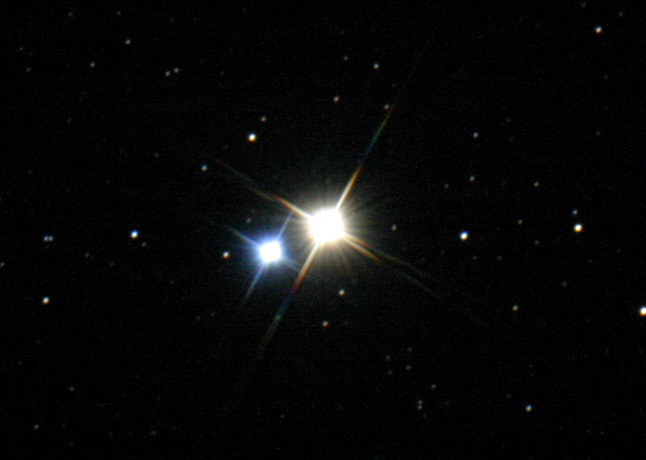
The swan’s head is marked by a visible, but much dimmer star named Albireo. That star sits approximately 1.6 fist widths to the upper right (or 16° to the celestial southwest) of Sadr – swans have long necks! Albireo is also parked close to the centre of the Summer Triangle asterism. Albireo is a favorite telescope target at summer star parties because it divides into a coloured double star when viewed in a small telescope. The two stars show a lovely sapphire (blue) and topaz (yellow) in colour – because they are burning at 11,000 K and 4,400 K, respectively.
Measurements from the Gaia space telescope indicate that Albireo is likely only a line-of-sight double – a happenstance of geometry. The brighter yellow star sits 328 light-years away from us, and the dimmer blue star is 389 light-years away. They’re close enough to one another to be gravitationally bound together – but Gaia found that they are travelling in much different directions – uncommon in stellar siblings. Albireo was given its single name before telescopes were invented and revealed that it was actually a duo. Its alternate designation is Beta1,2 Cygni – where the numerals refer to each partner.
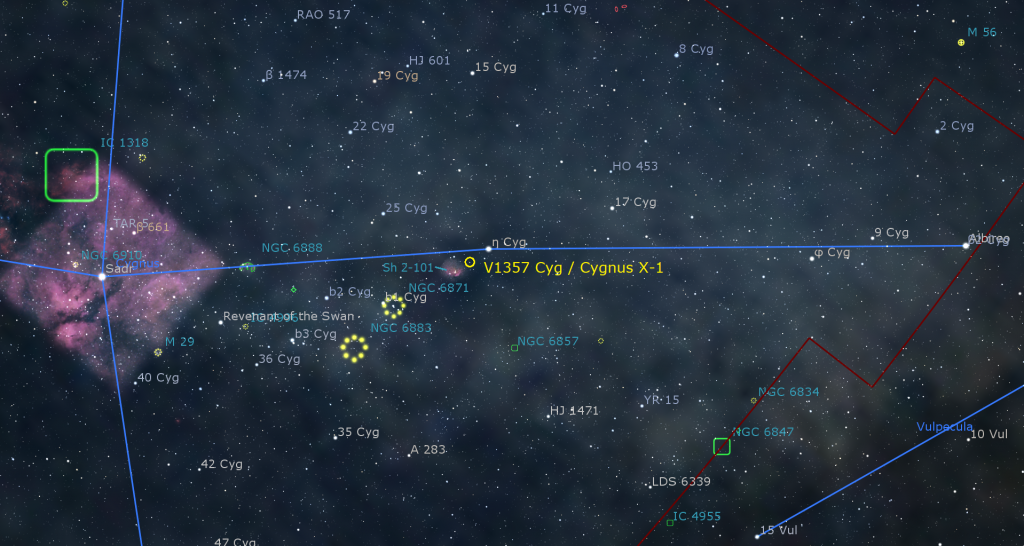
See if you can spot a medium-bright star positioned about midway along the swan’s long neck, between Sadr and Albireo. That’s Eta Cygni or (η Cyg), a warm-tinted star located about 135 light-years from Earth. This aging star has started to fuse Helium in its core. Strong binoculars and backyard telescopes can reveal a magnitude 8.8, blue-white star named HD 226868 and V1357 Cygni sitting 26 arc-minutes (a full moon’s diameter) to the lower left (or celestial east) of Eta. This hot, O-class star is emitting copious amounts of X-ray radiation.
In 1971, astronomer Tom Bolton of the University of Toronto used the 74” telescope at the David Dunlap Observatory in Richmond Hill, Ontario to analyze the light from V1357. He determined that something dark and massive was tugging it around in an orbit that repeated every 5.6 days. That invisible object came to be known as Cygnus X-1, the first confirmed black hole! The Canadian rock band Rush wrote a song about it. Listen to it on YouTube here! Astro-imagers who have photographed the nearby HII emission nebula named the Cygnus Star Cloud (or Sharpless 2-101) have likely included the Cygnus X-1 system, “invisible to telescopic eyes”!

With Deneb, Sadr, Eta Cygni, and Albireo running tail to head, you should now be able to locate a long, crooked chain of slightly dimmer stars arranged from lower left to upper right – forming the swan’s broad wings. Ancient Arab astronomers dubbed those stars “the Riders” – like a camel caravan, perhaps? Each wing extends about two fist diameters from Sadr and contains three stars. Let’s tour the wings.
Moving less than a fist’s width above (or 8° to the celestial northwest) from Sadr, we first arrive at Fawaris or Al Fawaris (“the Riders”) also known as Delta Cygni or (δ) Cyg. The star has also been called Rukh, after the giant Roc in Middle Eastern mythology (and some sword and sandal movies). Decent telescopes at high magnifications should be able to split that star into a pair of greenish-blue and yellow-white stars. Al Fawaris will also one day become Earth’s pole star.
A further jump of 7° to the upper left lands us at white Iota Cygni or (i) Cyg. A couple of finger widths beyond Iota sits yellowish Kappa Cygni or (κ) Cyg, the wingtip star. Kappa is an aging G-type star (like our sun) – buts it has swelled to almost ten times the size of the sun. Both Iota and Kappa sit about 120 light-years away from us. Kappa is sometimes labelled on sky charts as Fawaris I.
Let’s trace out the lower wing. Moving about 8° downwards from Sadr we find the bright, yellow-orange star Aljanah or Gienah, both names originating from the Arabic expression for “Wing of the Swan”. Also known as Epsilon Cygni or (ε Cyg), 72 light-years distant Gienah is an old star that is beginning its death process.
A palm’s width below Gienah you should spot a medium-bright, yellow-orange star named Zeta Cygni or (ζ Cyg). A little more bending to the left and another palm’s width lower is the tightly separated double star Mu Cygni or (μ Cyg). This pair of stars is orbiting one another with a period of about 790 years. Because their orbit is nearly edge on to us, they slowly move closer together and draw farther apart over the decades. Right now they are separating.

If you can leave the light polluted skies of the city, look for some of Cygnus’ wonderful nebulae – clouds of mainly hydrogen gas and dust that glow in pinks and blues – lit from within by the radiation emitted by the stars they contain. These large objects are best seen with binoculars, and sometimes your unaided eyes, under very dark, moonless skies. Check them out! A few finger widths below Deneb is the North American Nebula (NGC 7000), so-named for its distinctive shape. It’s quite easy to see as a faint, bright patch in binoculars. It’s more than three times larger than a full moon. The Pelican Nebula, a smaller patch to its upper right, is part of the same gas cloud – but separated from the other piece by dark foreground dust.
A faintly glowing region called the Gamma Cygni Nebula surrounds Sadr. This nebula, which is nearly 5,000 light-years away from us, spans six full moon diameters across! Sadr is not related to the nebula, though – the star is only half as far away as the nebula. Before moving on, look for an extra-dark patch of sky sitting two finger widths below Sadr. The patch, almost a fist diameter across and several finger widths tall is more dark interstellar dust that is blocking the light from the Milky Way’s stars beyond it. The patch is also known as the Northern Coalsack. (The larger, darker, true Coalsack Nebula is beside Crux, the Southern Cross. But it’s only visible from the Southern Hemisphere.)
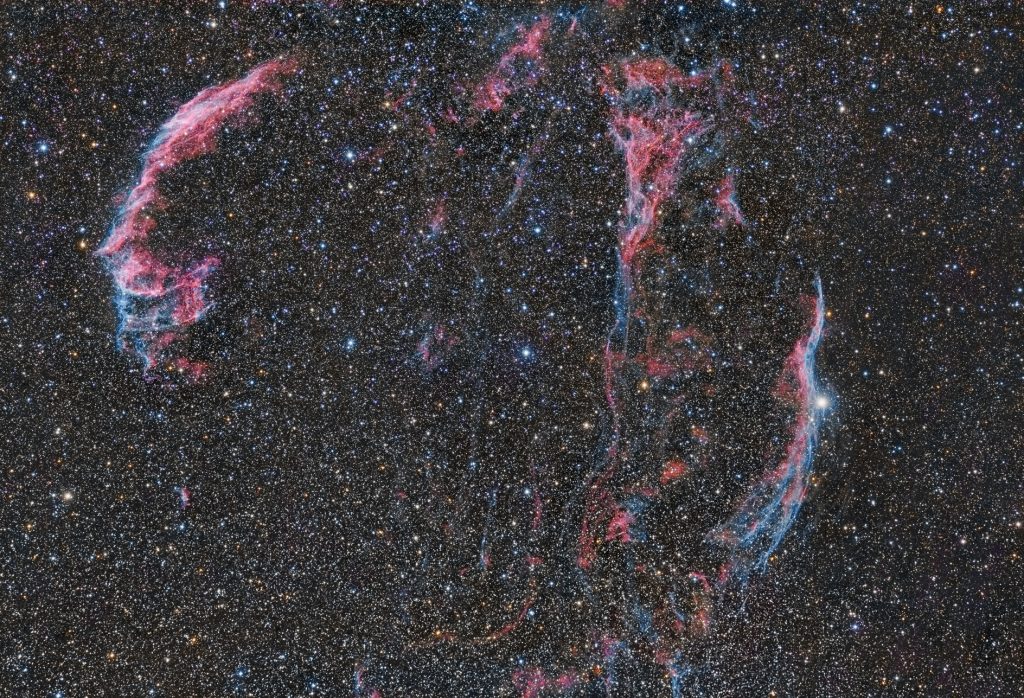
The large, delicate, and pink Veil Nebula or Cygnus Loop sits about three finger widths to the lower right of Gienah. Its roughly circular shape, five full moon diameters across, is the tattered remnant shell of a supernova that occurred five to eight thousand years ago. A particularly strong section of the nebula sweeps across a foreground star named 52 Cygni. That star sits a few finger widths to the lower right of Aljanah / Gienah. Put your lowest magnification eyepiece in your telescope, point it at 52 Cygni, and then look for a narrow slash of dim light crossing the field of view through the star. Then you can carefully follow the giant loop across the stars – especially if you have a nebula filter in your telescope.
Telescope owners should look for the Blinking Planetary. It’s a stellar corpse (like Lyra’s Ring Nebula) that plays an optical illusion on you. When you look straight at it, its central white dwarf shines as a tiny pinprick. But use averted vision, and a blue halo pops into view. You can make the halo appear and disappear by shifting your gaze. It’s fun! The object is located about two finger widths to the lower left of the line joining Fawaris and Iota Cygni (in the upper wing) – a bit closer to Iota.
If you are observing from a dark location, you should see that the band of the Milky Way runs directly through Cygnus – as if she is about to land on the river! The rich star fields surrounding the constellation are terrific for laying back and scanning with binoculars. You might find one of the many open star clusters in Cygnus, such as the Cooling Tower Cluster (Messier 29), which is located less than two finger widths to the lower right of Sadr, two more bright clusters along the neck below Eta Cygni, the bright cluster Messier 39 located a fist’s diameter to the lower left of Deneb, and several clusters surrounding Delta Cygni.
I wrote about the nebulas in Cygnus in the July-August, 2021 issue of SkyNews Magazine. Let me know how your exploration of Cygnus goes.
Public Astro-Themed Events
Every Monday evening, York University’s Allan I. Carswell Observatory runs an online star party – broadcasting views from four telescopes/cameras, answering viewer questions, and taking requests! Details are here. Their in-person Wednesday night viewing has been converted to online via the observatory YouTube channel.
Don’t forget to take advantage of the astronomy-themed YouTube videos posted by RASC Toronto Centre and RASC Canada.
On Wednesday evening, September 8 at 7:30 pm EDT, the RASC Toronto Centre will live stream their monthly Recreational Astronomy Night Meeting at https://www.youtube.com/rasctoronto/live. Talks include the Sky This Month (presented by me!), a review of some occultation software, and how the ancients weighed the Earth – Part II. Details are here.
On Saturday, September 11, from 8:30 to 11:30 pm, University of Toronto’s Dunlap Institute will hold their annual, free, star party – online! This year, the focus will be on planets. Astronomers will be live streaming views through their telescopes, and the panelists (including me) will cover indigenous astronomy, Jupiter exploration, and much more. And, there will be prizes! Details are here.
Public sessions at the David Dunlap Observatory may not be running at the moment, but we are pleased to offer some virtual experiences instead in partnership with Richmond Hill. The modest fee supports RASC’s education and public outreach efforts at DDO. On Sunday afternoon, September 12 from 12:30 to 1 pm EDT, join us for DDO Sunday Sungazing. Safely observe the sun with us, from the comfort of your home! During these family-friendly sessions, a DDO Astronomer will answer your questions about our closest star: the sun! Learn how the sun works and how it affects our home planet. Live-streamed views of the sun through small telescopes will be included, weather permitting. Only one registration per household is required. Deadline to register for this program is Wed., September 8, 2021 at 3 pm. Prior to the start of the program, registrants will be emailed the virtual program links. The registration link is here.
My free, family-friendly Insider’s Guide to the Galaxy webcasts with Jenna Hinds of RASC National will return on Tuesday, September 14 with our recommended astronomy and space books. You can find more details and the schedule of future sessions here. Note: If you registered for the Zoom series last year, you will have received an email asking you to please re-register before Tuesday. (We’re cleaning out older unused registrations to make room for new viewers from libraries across Canada this fall.)
Keep looking up, and enjoy the sky when you do. I love questions and requests. Send me some!